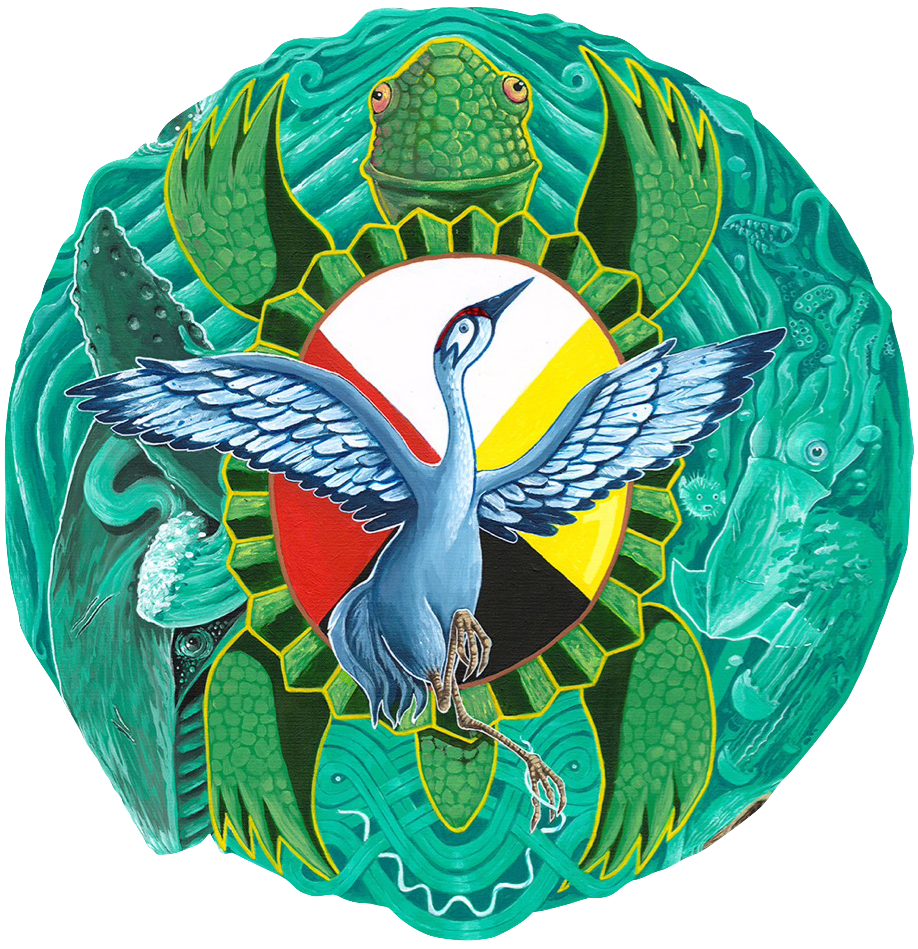ABOUT THE SHOW
Ajijaak on Turtle Island tells the story of Ajijaak, a young whooping crane. Separated from her family in a Tar Sands fire, Ajijaak must make her first migration from Wood Buffalo, Canada, down to the Gulf Coast on her own, finding her voice and a family through the interconnectedness of all of creation.
Ajijaak begins her travels with a medicine bundle, given to her by her parents, as her guide. She encounters deer, buffalo, coyote, and turtles as well as communities of people from Ojibwe, Ho-Chunk, Lakota, and Cherokee Nations, living in balance with their environments. These people share with Ajijaak prayers, songs, and dances that celebrate life on earth and help Ajijaak find the meaning and strength of her own song.
It is with this song that Ajijaak must restore balance and reciprocity to Turtle Island.
A reflection on life’s energy and how it connects all aspects of our world, Ajijaak on Turtle Island brings communities together through puppetry, music, traditional dances, animations, and kites. Ajijaak’s story puts forward visions from Indigenous communities, celebrating the symbiotic relationship between cranes and Native American/Indigenous peoples, and inspiring the next generation of storytellers, change-makers, and eco-champions.
The world premiere presentation of Ajijaak on Turtle Island was hosted at La MaMa in NYC, February 8-18, 2018.
FROM THE ORIGINAL DIRECTORS
Ty Defoe (L)
Niidiwaynimaginug, greetings all my relations!
Ajijaak on Turtle Island is a metaphor about how we need to take care of mother earth and one another. This story is written and is to be experienced from an Indigenous/First Nations perspective. Ajijaak and Mishibizhiw are entities in stories I would hear as a youth going to the round house. The symbolism of deer falling from birch bark trees, trickster coyotes teaching life lessons or grandmother moon giving advice to a granddaughter are all part of my classical literature. This is my reality. The teaching of giving is threaded throughout and it is subtle and comical as it humbly unfolds. I'm interested in seeing, hearing and experiencing ritual and ceremony as performance, the elemental forces of nature, and how we as humans can learn from the two-legged, four-legged, winged, rooted, and finned.
As you follow Ajijaak on her migration down the spine of Turtle Island (North America), she exchanges medicine from a variety of Indigenous/First Nations people as she honors the past, gives voices to the present and provides hope for the future. Ajijaak helps us to understand why survival, healing and thriving is important on the earth we all live on. This story is woven together with love and is a gift to the community at large, especially to all the youth. Unlock your arms, folks, and your imagination. Let's all rise and fly together!
To my mentors, family, and friends, a BIG MIIGWETCH for believing in my leadership. Special shout out to Warrior Women, like Mary Kathryn Nagle. I am grateful to all of the people on and off the stage whose contributions and experiences has been invaluable to this process as well as all of the artists’ over the years who have contributed their time, talents, and selves on the development: Vicki Williams, Sharon Day, Renee Sans Souci, Mary Kathryn Nagle, Kurtis Kirby III, Wade Belvins, Doug Good Feather, Kevin Locke, Waniya Locke, Joshua Aidan Dunn, Mawla Shawana, Larissa FastHorse, Dr. Carolyn Dunn, Bobby Gonzales, John Ross, Kristin Benavides, Phillip Stands, Marin Webster Denning, Siobhan Marks, Iakowine Oaks, Alaina Feehan, Wesley Whatley, Zayre Maria Ferrer, Melissa Bisagni, Dr. Ari Berk, Morgan Jenness, Dr. Daniel Banks, Uncle Jim, Patricia Defoe, Vernon Defoe, and the First Nations Theater Guild.
Whollay Wah!
- Ty Defoe (Oneida/Ojibwe Nations)
Heather Henson
My puppetry has always come from a place of empathy. What are the innate qualities of natural materials? How does a branch or tide breathe? How can we understand them enough to not just bring a puppet to life, but to become her? What do we learn through this process? Over my years of producing environmental spectacles, I have seen how puppets can be these powerful connectors to nature. I saw my first crane at the Rhode Island Zoo when I was a student intern. It was an orphaned Grey Crowned Crane and my job was to use the zoo’s crane puppet to encourage the baby to walk around its enclosure, strengthening its legs, while preventing it from imprinting on humans. I was fascinated by this bird and spent all of my lunch breaks reading all about these Cranes & the work of International Crane Foundation. As I read, I learned about the 15 species of cranes around the world, how each of them were reflected in the cultures of the communities that lived in proximity to these birds. In particular, I fell in love with the Whooping Crane.
Whooping Cranes have lived on what we call North America for millions of years. They sing and dance to communicate, raise their chicks for an entire year and are the most endangered of all cranes because of Western settler development. The more I learned about these birds, the more I learned about and met members of the Indigenous communities along their migration path. The knowledge carried by these birds continues to be carried by these vibrant communities. Telling the story of this resilient bird--who's migration path stitches together the far ends of our continent--allows us to bring together stories and teachings from the many First Nations peoples along Ajijaak's path. I am grateful beyond words to be able to bring together my passion for visualizing environmental issues with Ty’s incredible storytelling, our magnificent team of composers and the exceptional team of Native and Native-allied artists who have developed this show with us over many years. I’m grateful to be part of their flock. Thank you for joining us on this journey!
- Heather Henson




